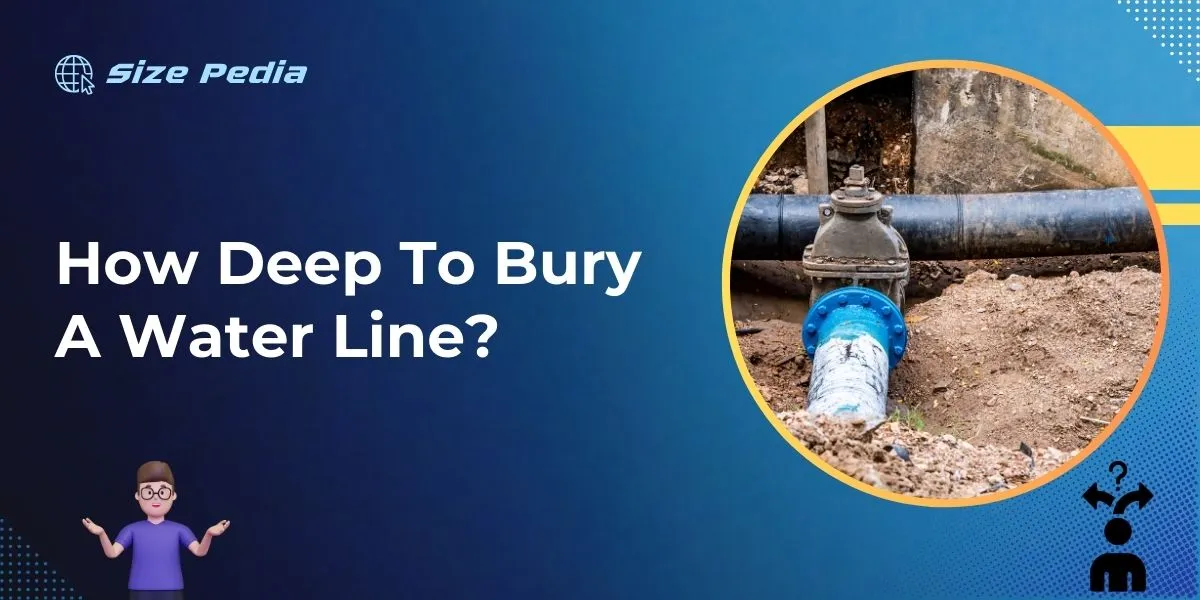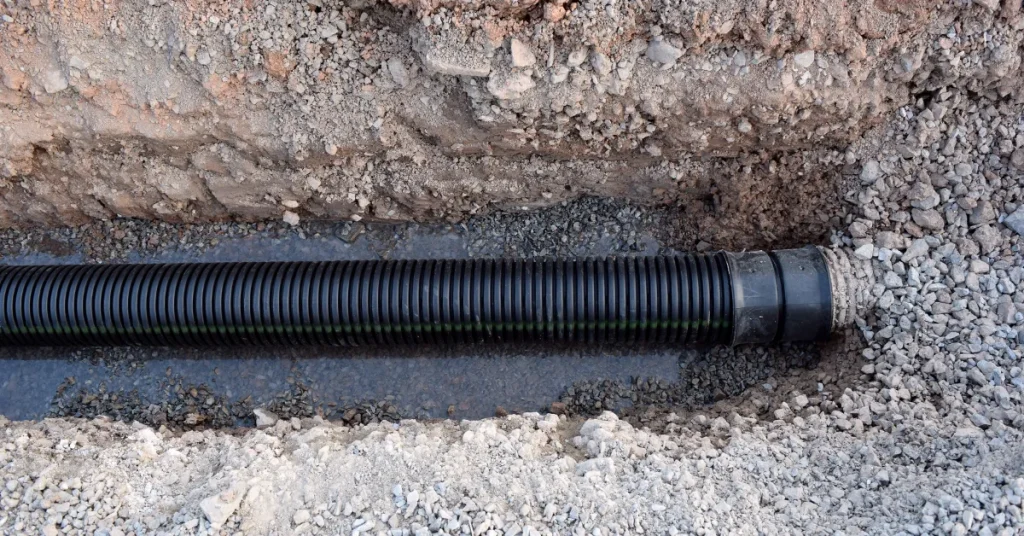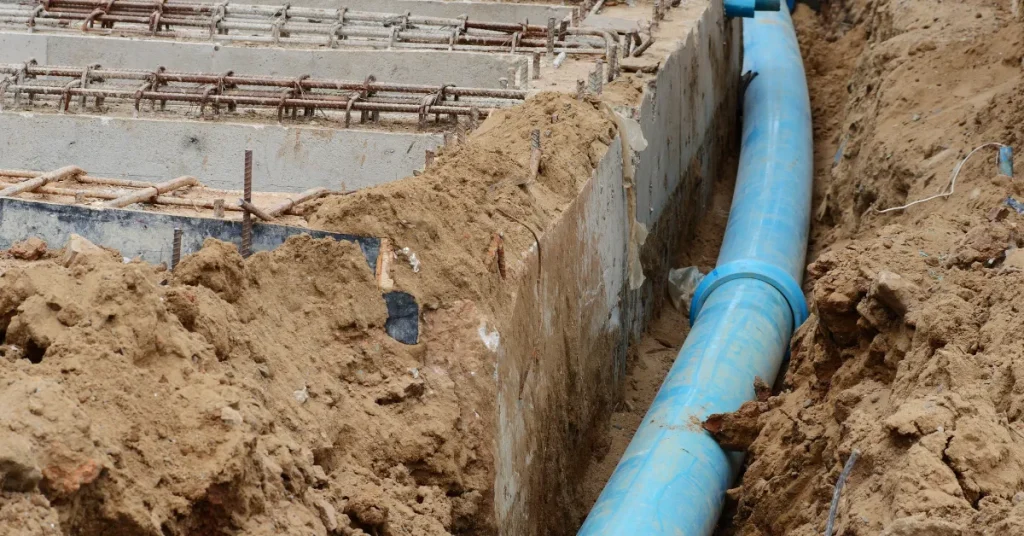Water lines should be buried at least 12 to 18 inches deep. The local building codes often dictate the exact depth.
Ensuring that your water line is properly buried protects it from freezing temperatures and potential damage.
The depth may vary depending on the region’s frost line, which is the depth to which the ground freezes. It’s critical to consult your local building code and utility companies before digging, as these regulations are in place to prevent service interruptions and damage.
A deep enough trench prevents the pipes from freezing and cracking, a common issue in colder climates. The right depth also shields water lines from accidental damage during gardening or construction activities.
Proper installation at the recommended depth is essential for the longevity and reliability of your water supply system.

The Importance Of Proper Burial Depth
The Importance of Proper Burial Depth cannot be understated when it comes to laying water lines. The right depth ensures safety, function, and longevity. Addressing this reduces the risk of freezing, protects against physical damage, and guards against contamination.
Settling on the sweet spot for your water line depth is not a one-size-fits-all scenario. It requires understanding specific factors that contribute to the longevity and reliability of your water system.
Factors Affecting Water Line Longevity
- Soil type: Sandy or rocky soils may drain well but can erode over time.
- Climate: Regions with severe freeze-thaw cycles demand deeper burials.
- Pipe material: Different materials have varying resilience to soil and water conditions.
- Water table level: High water tables may require specialized installation techniques.
- Traffic: Areas with heavy traffic or machinery need deeper lines for protection.
Risks Of Shallow Burial
Shallow water lines face numerous risks that can lead to costly repairs and interruptions in service:
| Risk | Consequence |
| Freeze and Thaw | Pipes can freeze, causing bursts or cracks. |
| Physical Damage | Lines are vulnerable to shocks and breaks from surface pressure. |
| Contamination | Shallow depths increase the potential for pollutants to seep in. |
A deeply buried water line affords peace of mind, while a shallow one triggers ongoing concerns. Account for every factor to protect your investment and ensure uninterrupted water supply.
Determining The Right Depth For Water Lines
Determining the right depth for water lines is crucial for a well-functioning plumbing system. This depth affects the line’s protection from freezing and physical damage.
Homeowners need to understand how deep to bury their water lines to assure long-term reliability and compliance with regulations.
Local Building Codes And Standards
Local building codes dictate the minimum depth for burying water lines. Governments set these standards to ensure safe drinking water and proper sanitation. Always start by checking with your city or county’s building department. Here’s what you should look for:
- Code requirements: Minimum depth specifications
- Inspection procedures: Steps to get your project approved
- Permit needs: Necessary paperwork before digging
Remember, ignoring these codes can lead to fines and costly repairs.
Environmental Considerations
The environment of your area influences how deep your water lines should be. Factors to consider include:
| Factor | Details |
| Climate | Areas with colder climates require deeper burial to prevent freezing. |
| Soil Type | Sandy or rocky soils may demand special installation techniques. |
| Landscaping | Root systems from trees can impact water line placement. |
Your choice must protect the water line from climate and physical damage. It must balance the need for depth with the potential impact on your yard’s landscape.
The Trench Digging Process

An essential stage in installing underground water pipelines is the trench digging process. Understanding the depth, method, and safety considerations are crucial for a successful installation.
This process lays the foundation for a stable water line that can resist freezing temperatures and external pressures.
Diy Vs. Professional Excavation
Determining whether to dig your water line trench by yourself or to hire professionals can depend on various factors such as skill, available time, and budget. Below are points to consider:
- Experience: Professional excavators have the skills to navigate underground utilities.
- Speed: Experts can complete the job quickly with their experience and equipment.
- Risk: DIY digging poses risks if you are unfamiliar with underground hazards.
Safety Measures And Equipment
Whether you choose to DIY or go professional, safety is paramount during the excavation. Notable safety practices include:
- Calling 811 before digging to locate any existing underground utilities.
- Wearing protective gear such as gloves, hard hats, and safety goggles.
- Using the proper tools like a trencher or a shovel for smaller jobs.
Equipment for the job must suit the soil type and trench depth requirements.
| Equipment Type | Use Case |
| Trencher | Efficiently cuts through soil, ideal for longer trenches. |
| Excavator | For deeper and wider excavation. Provides precision. |
| Shovel | Best for minor, shallow digging and fine adjustments. |
Using correct equipment ensures a smooth and safe excavation while minimizing disruptions to the surrounding area.
Materials Matter: Choosing The Right Pipes
As you plan to bury a water line, selecting the right pipes is pivotal.
The materials used for your underground water pipes affect everything from water quality to maintenance needs.
Different pipe materials offer varying benefits and challenges. It is essential to understand these differences.
Types Of Water Pipes
Various kinds of pipes are suitable for water lines. These include:
- PVC Pipes – Lightweight and easy to work with
- Copper Pipes – Known for their longevity
- PEX Pipes – Flexible and resistant to freeze-breakage
- Galvanized Steel Pipes – Sturdy but prone to corrosion
Longevity And Durability Of Materials
Selecting durable materials means less maintenance. Pipes vary greatly in their lifespan:
| Material | Expected Lifespan |
| PVC | 50-70 years |
| Copper | 70+ years |
| PEX | 40-50 years |
| Galvanized Steel | 20-50 years |
PVC pipes rank high in both the ease-of-installation and cost-effectiveness categories.
Copper pipes, though more expensive, are tough and less prone to leakage.
PEX pipes, a newer material, offer durability and are good for areas with extreme temperatures.
Old-fashioned galvanized steel is strong but may rust over time, leading to potential water quality issues.
Choose materials that balance cost, ease of installation, and longevity to ensure a reliable water supply system for your home or property.
Insulation And Protection Strategies
Proper insulation and protection of water lines are crucial for their longevity and efficiency. Ensuring that water lines are at the correct depth is just the start.
It’s important to implement strategies to prevent damage from freezing temperatures and potential contaminants. Follow these key strategies to protect your water lines and provide reliable access to water year-round.
Preventing Freezing
To keep water lines from freezing, additional measures are vital. The depth at which you bury the line plays a role but insulation offers a protective layer against the cold. Wrap water pipes with specially designed foam or fiberglass insulation to maintain a steady temperature.
Consider the use of heat tape for added protection in particularly vulnerable areas. Bulked-up insulation coupled with correct burial depth forms a robust defense against the icy clutches of winter.
Employing these strategies can mean the difference between a reliable water supply and unexpected disruptions:
- Choose proper insulation materials that suit your regional climate.
- Monitor ground temperature and apply supplemental heating elements if necessary.
- Consider the installation of pipe sleeves for an extra layer of protection.
Avoiding Contamination
Safe drinking water is a must. Burying water lines deep isn’t just about preventing freezing—it also helps shield them from pollutants. Contamination can come from surface chemicals, pesticides, and even animal waste. Layers of soil act as a natural barrier.
To minimize the risks, here are effective strategies:
- Ensure the water line is below the frost line and away from sewage systems.
- Use durable pipes resistant to cracks where contaminants could enter.
- Implement backflow prevention devices to guard against reverse flow of contaminated water.
Regular check-ups and maintenance keep the water clean and free of harmful elements. Shield your water supply through strategic burial and safeguarding tactics.
Post-burial Checklist

Completing the installation of a water line doesn’t end with burying it underground. A vital post-burial checklist ensures everything is in tip-top shape.
Pressure Testing The Lines
Before backfilling, a critical step is to pressure test the lines. This guarantees that there are no leaks and that the piping can handle the required water pressure.
- Fill the system with water and increase the pressure to the recommended level.
- Hold the pressure for a prescribed duration, usually several hours.
- Monitor the pressure gauge; no drop indicates a successful test.
Backfilling Best Practices
Backfilling secures the piping and restores the landscape. Yet, only certain material and methods can prevent future issues.
- Avoid sharp objects: Use sand or clean fill to protect pipes from rocks.
- Tamp down in layers: Each layer should be compacted to prevent settling.
- Grade the area: Ensure proper water runoff and prevent pooling around the line.
Each step is crucial to maintain integrity and functionality of your water line for years.
FAQs About How Deep To Bury A Water Line
What Is The Standard Depth For Burying Water Lines?
The standard burial depth for water lines is about 12 to 18 inches. This depth helps to protect against freezing and mechanical damage. Local building codes may mandate specific depths based on regional climate and soil conditions.
How Does Climate Impact Water Line Burial Depth?
Climate significantly impacts burial depth, with colder regions requiring deeper burial to prevent freezing. Typically, lines are buried below the frost line to avoid the risk of pipes freezing and bursting, which varies by geographic location.
Can Soil Type Affect How Deep Water Lines Are Laid?
Yes, soil type can affect water line burial depth. Sandy or loose soils may require deeper trenches and additional support to prevent pipe shifting. Clay or rocky soils might have different requirements based on stability and potential for ground movement.
Are There Regulations For Burying Water Lines?
Absolutely, local building codes and regulations dictate the minimum depth for burying water lines. It’s essential to consult with local authorities and obtain necessary permits to ensure compliance with regional standards and safety measures.
Conclusion
Burying a water line at the proper depth is crucial for its longevity and function. Always consult local codes and consider frost lines to prevent freezing.
Regular maintenance and inspection are key to avoid costly repairs. To safeguard your water supply, proper burial depth is a small step with significant impact.
Choose wisely, dig safely.
